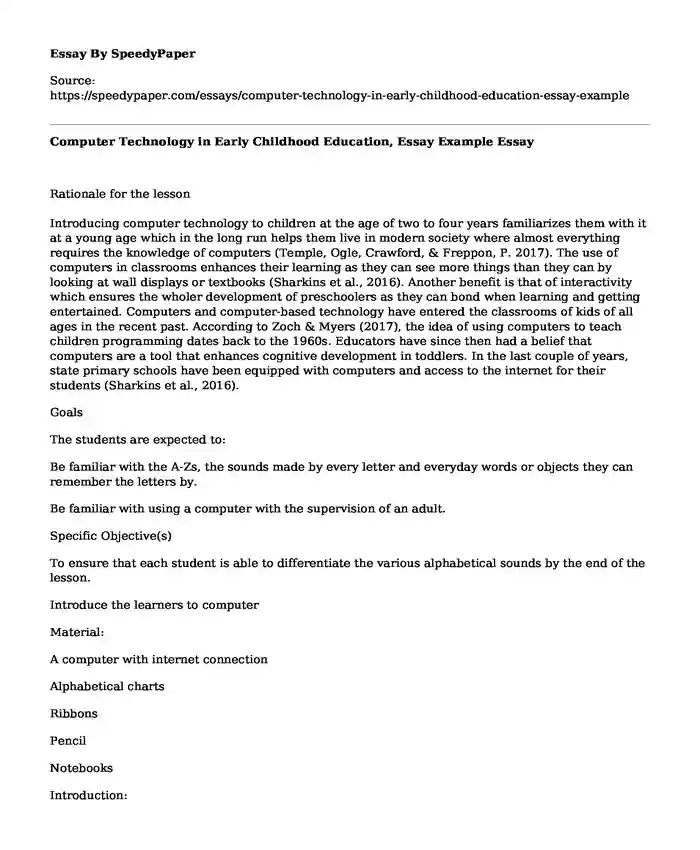
| Type of paper: | Essay |
| Categories: | Teaching Education Computer science |
| Pages: | 4 |
| Wordcount: | 851 words |
Rationale for the lesson
Introducing computer technology to children at the age of two to four years familiarizes them with it at a young age which in the long run helps them live in modern society where almost everything requires the knowledge of computers (Temple, Ogle, Crawford, & Freppon, P. 2017). The use of computers in classrooms enhances their learning as they can see more things than they can by looking at wall displays or textbooks (Sharkins et al., 2016). Another benefit is that of interactivity which ensures the wholer development of preschoolers as they can bond when learning and getting entertained. Computers and computer-based technology have entered the classrooms of kids of all ages in the recent past. According to Zoch & Myers (2017), the idea of using computers to teach children programming dates back to the 1960s. Educators have since then had a belief that computers are a tool that enhances cognitive development in toddlers. In the last couple of years, state primary schools have been equipped with computers and access to the internet for their students (Sharkins et al., 2016).
Goals
The students are expected to:
Be familiar with the A-Zs, the sounds made by every letter and everyday words or objects they can remember the letters by.
Be familiar with using a computer with the supervision of an adult.
Specific Objective(s)
To ensure that each student is able to differentiate the various alphabetical sounds by the end of the lesson.
Introduce the learners to computer
Material:
A computer with internet connection
Alphabetical charts
Ribbons
Pencil
Notebooks
Introduction:
The teacher will greet the students, welcome them to the lesson and inquire about how they have been doing since their last lesson.
The teacher will check the register.
The teacher will ask the students what they remember from the last lesson and insist that whoever wants to speak should raise their hand.
The teacher will ask the students to mention some of the alphabetical letters they may know.
The teacher will introduce the lesson of the day while ensuring every student is paying attention.
Motivation:
The teachers will the students various objects starting with names the various alphabetical letters. The students will then be grouped in groups of five and then asked to name the objects.
The teacher will explain to the class that the day's lesson is easy and interesting and that whoever does not understand at any point should feel free to raise their hand and ask for clarification.
Ask the leaners will sing the alphabetic song
Procedure:
The teacher will explain what alphabets are to the students in the best way they can understand.
Having learned about computers in previous classes, the teacher will explain how the computer will be incorporated into the day's class and that the teacher will be in charge of operating it.
The teacher will log in to the appropriate site. The computer will be connected to a screen to enable everyone have access to what is on the computer and the working of the program.
To get the students to learn how the program works, the teacher will operate the computer and make the students understand the program. In so doing, the students will be asked to say the letters out loud, make sounds made by every letter, and name the objects that remind them of each letter.
The teacher will take the students through how to use the program and then set up the program on the computer for the children to explore during their break period.
The teacher will direct a few questions to the students to check whether or not the objectives of the lesson were achieved.
The teacher will give the students a glimpse of what they will do on the next lesson.
The teacher will give homework and end the class.
Evaluation
By the end of the class, the objective of the lesson should be achieved.
The learners' ability to identify different alphabetic letters correctly will be used to assess their understanding of the lesson contents.
Summary
The lesson will help the learners be able to differentiate the alphabetical letters as well as be introduced to computer. The lesson will be conducted both digitally and manually; both computer and conventional teaching approaches will be employed. At the end of the lesson, the learners must be able to give a summary of what they have learned and respond to the class questions.
Closure
The teacher will end the lesson by summarizing the topic of the day
The teacher will give the students individual assignments to be reviewed in the next lesson.
Reference
Sharkins, K. A., Newton, A. B., Albaiz, N. E. A., & Ernest, J. M. (2016). Preschool children's exposure to media, technology, and screen time: Perspectives of caregivers from three early childcare settings. Early Childhood Education Journal, 44(5), 437-444.
Temple, C. A., Ogle, D., Crawford, A. N., & Freppon, P. (2017). All children read: Teaching for literacy in today's diverse classrooms. Pearson.
Zoch, M., & Myers, J. (2017). Teachers' Engagement with New Literacies as Support for Implementing Technology in the English/Language Arts Classroom. Contemporary Issues in Technology and Teacher Education, 17(1), 25-52.
Cite this page
Computer Technology in Early Childhood Education, Essay Example. (2022, Mar 01). Retrieved from https://speedypaper.net/essays/computer-technology-in-early-childhood-education-essay-example
Request Removal
If you are the original author of this essay and no longer wish to have it published on the SpeedyPaper website, please click below to request its removal:
- Essay Example on Foundations of Spirituality in Healthcare
- Free Personal Essay Example: My Hobby - Soccer
- Free Essay Example on Work Breakdown Structure
- Free Essay on Continuing Professional Development (CPD)
- Criminal Law and Corrections, Essay Example
- Essay Example about Business Laws and Regulations
- Free Argumentative Essay on Smartphone Controversy
Popular categories




